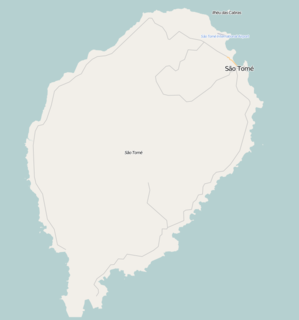
The Mozambique Channel is an arm of the Indian Ocean located between the Southeast African countries of Madagascar and Mozambique. The channel is about 1,600 km (1,000 mi) long and 419 km (260 mi) across at its narrowest point, and reaches a depth of 3,292 m (10,800 ft) about 230 km (143 mi) off the coast of Mozambique. A warm current, the Mozambique Current, flows in a southward direction in the channel, leading into the Agulhas Current off the east coast of Southern Africa.
Paved and unpaved roadways, as well as railways, provide the main forms of transport in Madagascar. Madagascar has approximately 31,640 km (19,660 mi) of paved roads and 836 km of rail lines. In 2010, Madagascar had 432 km (270 mi) of navigable waterways.

Moroni is the largest city, federal capital, and seat of the government of the Union of the Comoros, a sovereign archipelago nation in the Indian Ocean. Moroni means "at the river". Moroni is the capital of the semi-autonomous island of Ngazidja, the largest of the three main islands of the republic. The city's estimated population in 2003 was 41,557 residents. Moroni, which lies along the Route Nationale 1, has a port and several mosques such as the Badjanani Mosque.

Pico de São Tomé is the highest mountain in São Tomé and Príncipe at 2,024 m (6,640 ft) elevation. It lies just west of the centre of São Tomé Island, in the Parque Natural Obô de São Tomé and in the Lembá District. The second highest point, Pico de Ana Chaves, lies about 3 km to its south east. The town Santa Catarina is 8 km to the west.

The Malagasy or striped civet, also known as the fanaloka or jabady, is an euplerid endemic to Madagascar.

Mananjary is a city located in Vatovavy, Madagascar with a population of 25 222 inhabitants in 2018. It is the chief city of the Mananjary district.

Mtsamboro is a small fishing town and commune in northwest Mayotte, a French overseas department in the Indian Ocean. Its population according to the 2017 census is 7,705. Included in the commune are the Choazil Islands and Chissioua Mtsamboro. The main economic activity is fishing and orange production.

Hilary Bradt MBE is the founder of Bradt Travel Guides, a publisher which became an increasingly visible presence in the travel guide book world starting in the mid-1970s.

The composition of Madagascar's wildlife reflects the fact that the island has been isolated for about 88 million years. The prehistoric breakup of the supercontinent Gondwana separated the Madagascar-Antarctica-India landmass from the Africa-South America landmass around 135 million years ago. Madagascar later split from India about 88 million years ago, allowing plants and animals on the island to evolve in relative isolation.

Salanoia is a genus of euplerid carnivoran with two currently described species found in Madagascar. They are mongoose-like, which is reflected in the older versions of their English names, for example brown-tailed mongoose which is now called brown-tailed vontsira. The name Salanoia is derived from salano, one of the vernacular names for Salanoia concolor.

Saint Augustin is a town and commune in Madagascar. It belongs to the district of Toliara II, which is a part of Atsimo-Andrefana Region. The population of the commune was estimated to be approximately 15,000 in 2001 commune census. The mouth of the Onilahy River is near the town.

Bitam is a town in northern Gabon on the N2 road on the border with Cameroon. As of the 2013 census, its population is 27,923.

Santa Clara is a beach town in Coclé Province, Panama. The settlement is a small fishing village with tourist lodgings and Panamanians' weekend homes. It is located just off the Inter-American Highway, 11 km southwest of the El Valle turnoff and 100 km southwest of Panama City. The closest town is beach resort Farallón. Santa Clara's stretch of white sand beach is relatively uncrowded, and there are more locals and fewer tourists in Santa Clara than at other nearby beaches.

Jane Wilson-Howarth BSc, CF, MSc, BM, DCH, DCCH, DFSRH, FFTM RCPS is a British physician, lecturer and author. She has written three travel health guides, two travel narratives, a novel and a series of wildlife adventures for children. She has also contributed to anthologies of travellers tales, has written innumerable articles for non-specialist readers, and many scientific/academic papers.
Yemen German Hospital is a hospital in Sana'a, Yemen. It is located in the south of the city, southwest of Al Sabeen Maternal Hospital and immediately south of Fun City along the 60 meters road and Hadda Street.

Lake Jipe is an inter-territorial lake straddling the borders of Kenya and Tanzania. On the Kenyan side, it is located south of the village of Nghonji while on the Tanzanian side, it is situated within Mwanga District, in Kilimanjaro Region. The lake is fed mainly by the Lumi River, which descends from Mount Kilimanjaro, as well as streams from the North Pare Mountains, being on the leeward side. The lake's outlet forms the Ruvu River. Kenya's unfenced Tsavo West National Park protects part of the lake's northern shore, while on the Tanzania side Mkomazi Game Reserve is nearby. The lake is known for its endemic fish, as well as water birds, mammals, wetland plants and lake-edge swamps, which can extend 2 kilometres (1.2 mi) from Jipe's shore.

The Mahajamba is a river of northern Madagascar. It flows through Ankarafantsika National Park. The river is surrounded in mangroves.

The Tsiribihina or Tsiribinha is a river of western Madagascar. It flows through Tsingy de Bemaraha National Park. The river is surrounded by mangroves.

Mahanoro is a city and urban municipality located in the Atsinanana region of eastern Madagascar, along the coast.
Time in Madagascar is given by a single time zone, officially denoted as East Africa Time. Madagascar does not observe daylight saving time.


















